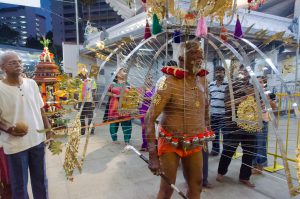Made in Singapore: Conceiving, Making and Using Ritual Objects in Hindu Domains
September 26, 2022

Ganesh Chaturthi is an annual Hindu festival usually falling during the months of August or September. It commemorates the birthday of Lord Ganesh, who was believed to be born around noon. Ganesh Chaturthi is one of the many Hindu festivals celebrated around the world. In Singapore, we are more familiar with Taipusam, which is celebrated by the Hindu Tamil community.
Images of Hindus bearing the kavati (an elaborate metal structure that supports a deity’s shrine) are commonly associated during Taipusam festivals. Usually, kavatis and other religious objects are created by spiritual leaders and skilled tradesmen from India. However, they are increasingly produced by Singaporean entrepreneurs who do not necessarily have the expertise to do so. In ‘Made in Singapore: Conceiving, Making and Using Ritual Objects in Hindu Domains’ (New Religiosities, Modern Capitalism, and Moral Complexities in Southeast Asia, 2017), Professor Vineeta Sinha (NUS Sociology & Anthropology) examines how this new phenomenon of localised production and consumption of religious objects in Singapore enables Singaporean entrepreneurs to reconfigure their religious lives.
Prof Sinha observes some everyday Hindu devotees personalising their kavatis. Instead of the traditional practice of procuring kavatis from caste experts, these devotees willingly undertake an intricate ornamentation process through which they represent their emotional and spiritual relations with deities. Everyday devotees thus become both the creator and the consumer of religious objects. Prof Sinha argues that this reconfigured relationship opens up new grounds to explore how religious practices and religious lives are transforming in the contemporary era.
Read the full article here.
